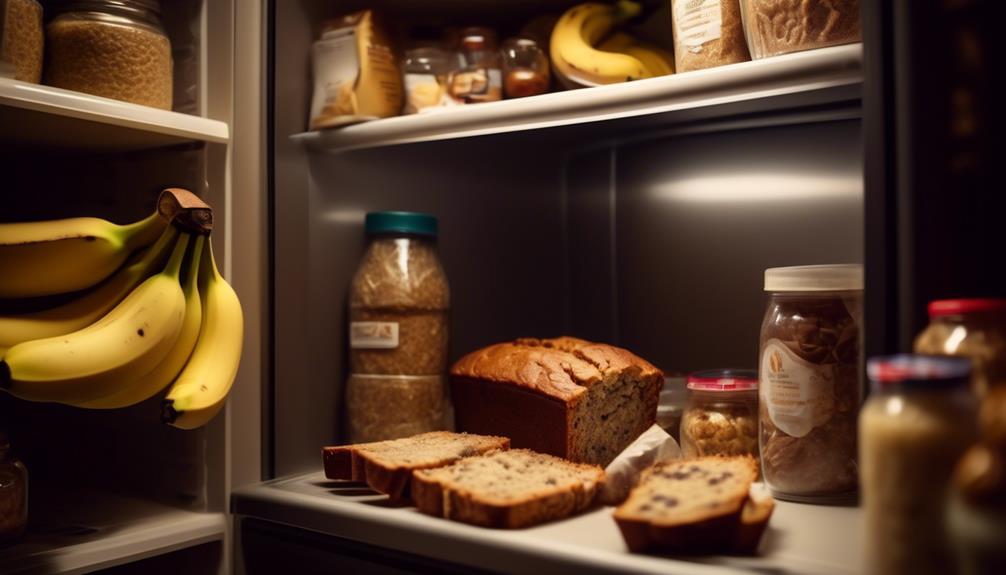Can You Put Banana Bread in the Fridge
Just as an artist painstakingly chooses their palette, you too must carefully select how to store your culinary masterpiece, the banana bread. After all, it's not just a loaf but a symbol of your effort and care baked into a golden, aromatic delight.
But here's a question that often baffles many—should you put your banana bread in the fridge? There are a few schools of thought on this, and each presents valid arguments.
In this enlightening exploration, we will navigate the science of baking, the role of refrigeration in preservation, and the impact of cold storage on your beloved banana bread. But remember, like the many layers of flavor in your bread, this topic too, unfolds in intriguing ways.
So, let's embark on this journey, shall we?
Understanding Banana Bread Storage

Often, you'll find that properly storing your banana bread can significantly extend its freshness and taste, turning a quick breakfast option into a delightful treat for days. To comprehend this, it's critical to conduct a bread composition analysis. Understanding the ingredients and their roles can provide insights into why certain storage methods work best.
Moisture content, for example, affects how quickly bread stales.
Moreover, different banana bread variations may require unique storage methods. Some recipes might include perishable add-ins, such as fresh fruits or dairy, which could shorten their shelf-life.
Hence, whether you've made a classic banana bread or experimented with a new variation, it's essential to know the best storage techniques to retain its taste and quality.
The Science of Baking Banana Bread
Delving into the science of baking banana bread, you'll uncover the fascinating interplay of ingredients that gives this humble loaf its distinctive flavor and texture. Your choice of ingredients, particularly the ripeness of the bananas, directly influences the sweetness and moisture content. Overripe bananas, rich in natural sugars, contribute a deeper, caramel-like flavor.
Baking techniques also play a pivotal role. The creaming method, where butter and sugar are beaten until fluffy before adding other ingredients, results in a lighter, more tender crumb. Meanwhile, the quick bread method, with ingredients simply stirred together, yields a denser texture.
Understanding these aspects allows you to create variations in taste and texture, tailoring your banana bread to your preference.
The Role of Refrigeration in Preservation

Just as understanding the science of baking banana bread can elevate your culinary creations, appreciating the role of refrigeration in preservation can significantly extend their shelf life.
A brief look at refrigeration history reveals that it revolutionized food storage, reducing spoilage and waste. Refrigeration slows down the growth of bacteria and mold, which thrive in warmer environments.
By creating a cold environment, the effects are a considerably slowed deterioration process, preserving the texture and taste of your banana bread longer. It's important to wrap it tightly to prevent it from drying out.
Impact of Cold Storage on Banana Bread
Storing your banana bread in the refrigerator can have a profound impact on its freshness, texture, and overall quality.
The cold environment slows down the staling process, preserving its original taste longer.
However, bread texture changes are inevitable. The fridge's low temperature can make your banana bread hard and dry.
This is due to retrogradation, a process where the starch molecules in the bread reorganize and recrystallize, leading to a tougher texture.
Pros of Refrigerating Banana Bread

Despite the potential for texture changes, refrigerating your banana bread offers several significant benefits worth considering.
- First, it aids in flavor intensification. The cooling process allows the flavors to meld together, making your banana bread taste richer and more robust with every bite.
- Second, refrigeration extends freshness. By keeping your bread in the fridge, you're slowing down mold's growth, giving you more time to enjoy your treat.
- Lastly, it creates a firmer bread texture. If you prefer a less crumbly, more solid bite, refrigeration can help achieve that.
Cons of Refrigerating Banana Bread
While refrigeration can enhance your banana bread's longevity and flavor, it's essential to consider the potential drawbacks that could affect your overall enjoyment.
Firstly, refrigeration can cause banana bread discoloration. This mightn't affect the taste, but visually, it's less appealing.
Secondly, there's the refrigeration impact on flavor. Cold temperatures can mute the flavors of your banana bread, making it taste less sweet and flavorful than when it was fresh. Your bread might also absorb other flavors present in your fridge, altering its original taste.
Lastly, refrigeration can change the bread's texture, making it harder and less enjoyable to eat.
It's crucial to weigh these factors before deciding to refrigerate your banana bread.
Alternative Storage Methods for Banana Bread

If the drawbacks of refrigerating banana bread give you pause, you'll be delighted to know there are other effective methods to store your loaf and ensure it stays fresh. These alternatives provide optimal conditions for preserving your bread's quality, taste, and texture.
- Bread Box: Bread box benefits are numerous.
- Retains Moisture: They're designed to balance airflow and keep the bread from drying out.
- Prevents Mould: The slight ventilation prevents condensation build-up, reducing mould formation.
- Vacuum Sealing: Vacuum sealing efficacy is notable.
- Longevity: It removes air, reducing oxidation and increasing shelf-life.
- Freshness: Your bread retains its freshness far longer than traditional storage methods.
- Freezer: A well-wrapped loaf can be frozen for up to 3 months without losing its quality.
Choose the method that best suits your needs and enjoy your banana bread at its finest.
How to Properly Refrigerate Banana Bread
To properly refrigerate your banana bread and ensure its freshness, it's essential you follow a few critical steps.
First, let the banana bread cool completely. This prevents condensation, a key player in bread mold prevention.
Once cooled, wrap it tightly in plastic wrap or aluminum foil. This helps retain moisture and prevents exposure to air, which can cause the bread to dry out or mold.
If your banana bread ingredients include perishables like cream cheese, refrigeration is necessary.
Lastly, place the wrapped bread in a resealable bag or an airtight container. Store in the fridge, ideally at a temperature between 35 to 40°F.
Moisture and Banana Bread: A Delicate Balance

Balancing moisture in your banana bread is a delicate art, crucial in preserving its delicious, moist texture without inviting unwanted mold growth. Here's the rub: too much moisture is a breeding ground for molds, yet insufficient moisture can lead to a dry, unappetizing loaf.
Consider these aspects:
Banana bread ingredients: These play a vital role in moisture regulation. For instance:
- Bananas: They naturally contain a high percentage of water, contributing to the bread's moisture content.
- Flour: It absorbs moisture, helping to maintain the bread's structural integrity.
Moisture absorption techniques: These are key in preserving your loaf. Here are some ideas:
- Wrapping: Properly wrap your bread in plastic or foil to reduce moisture loss.
- Storing: Keep it in a breadbox or airtight container to manage humidity levels.
The Shelf Life of Refrigerated Banana Bread
Ever wondered how long your banana bread will last in the refrigerator? It's a common question and the answer hinges largely on bread mold prevention and the specific banana bread ingredients used.
Typically, refrigerated banana bread can last up to a week, sometimes even longer if properly stored. Refrigeration slows down the growth of molds, which are the main culprits behind bread spoilage.
To extend your banana bread's lifespan, wrap it tightly in plastic wrap or store it in an airtight container. Remember, moisture is a friend of mold, so ensure your bread is completely cool before refrigerating.
Lastly, consider the freshness of your ingredients before baking; fresher ingredients will yield longer-lasting banana bread.
Freezing Banana Bread: A Viable Option?

If you're looking for a way to keep your banana bread fresh for even longer, freezing might just be your best option. You can freeze both regular and vegan banana bread effectively. Here's how:
- Preparation: Cool your bread completely before freezing. Wrap it tightly in plastic wrap, then in aluminum foil.
- For Banana bread toppings, it's best to add these after thawing to maintain texture.
- Storage: Keep your wrapped banana bread in the freezer. The double-wrapping prevents freezer burn.
- Thawing: When you're ready to eat, thaw at room temperature. Vegan banana bread may thaw faster due to its ingredients.
Freezing is a viable option that allows you to enjoy your banana bread anytime. Just remember, proper preparation is key to maintaining quality and taste.
Room Temperature Storage: Pros and Cons
While freezing offers a longer shelf life for your banana bread, storing it at room temperature is a convenient and common practice that comes with its own set of pros and cons.
One of the significant advantages is that the banana bread ingredients retain their original texture and taste, unlike freezing which can sometimes alter these aspects.
On the flip side, the shelf life of banana bread kept at room temperature is relatively short, typically 2-3 days. Prolonged exposure to room temperature may also lead to drying out of the bread, reversing the moist effect of oven baking.
However, if you're planning to consume it quickly, room temperature storage works wonderfully without the need for defrosting.
How to Reheat Refrigerated Banana Bread

When you're ready to enjoy your refrigerated banana bread, reheating it properly can enhance its flavor and restore its original moist texture.
Here's how to ensure you achieve this:
- Preheat your oven to 350 degrees Fahrenheit.
- While it's heating up, wrap your banana bread in aluminum foil to lock in moisture.
- Bake for about 15 minutes.
However, be aware of these potential microwave risks:
- Overheating can cause the bread to become dry or hard.
- Uneven heating may occur, resulting in some parts being hotter than others.
To further enrich your reheated banana bread, consider these banana bread toppings:
- Spread a light layer of butter or cream cheese.
- Drizzle with honey or sprinkle with cinnamon for added sweetness.
Common Mistakes in Banana Bread Storage
Avoiding mishaps in your banana bread's storage isn't as tricky as you might think, but there are common mistakes you'll want to sidestep. The most prevalent error is leaving it exposed, which accelerates banana bread mold. Always store it in airtight containers or wrap it in cling film to maintain freshness.
Another mistake is using overripe bananas, which impacts the bread's texture and longevity. Overripe bananas can make your bread too moist, leading to quicker spoilage. Always aim for just ripe bananas for optimal results.
Lastly, don't refrigerate immediately after baking. Let it cool completely to avoid condensation within the container, which can also lead to mold. Proper storage extends your banana bread's shelf life, ensuring you can enjoy it longer.
Expert Tips for Best Banana Bread Storage

Mastering the art of storing banana bread can significantly enhance its taste, texture, and overall shelf life. The key lies in proper baking variations and ingredient selection.
Here are some expert tips to consider:
Baking Variations:
- Altering your baking method can impact the bread's moisture content. Try baking at a lower temperature for a longer duration to ensure even cooking and retention of moisture.
Ingredient Selection:
- The quality of your ingredients can greatly affect the bread's longevity. Opt for fresh, high-quality ingredients for best results.
- Try to select ripe bananas. They add natural sweetness and moisture, extending the bread's freshness.
Conclusion
In conclusion, you can indeed refrigerate banana bread, but it's crucial to know the pros and cons. Cold storage can extend freshness, yet may alter the texture.
Room temperature storage is fine for short periods. Always remember to properly wrap your bread to retain moisture.
Reheating is a delicate process, so be cautious. Avoid common mistakes and follow expert storage tips for the best results.
Ultimately, the choice is yours based on your preferences and needs.




